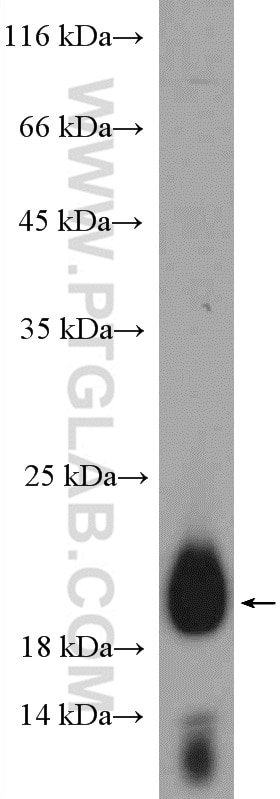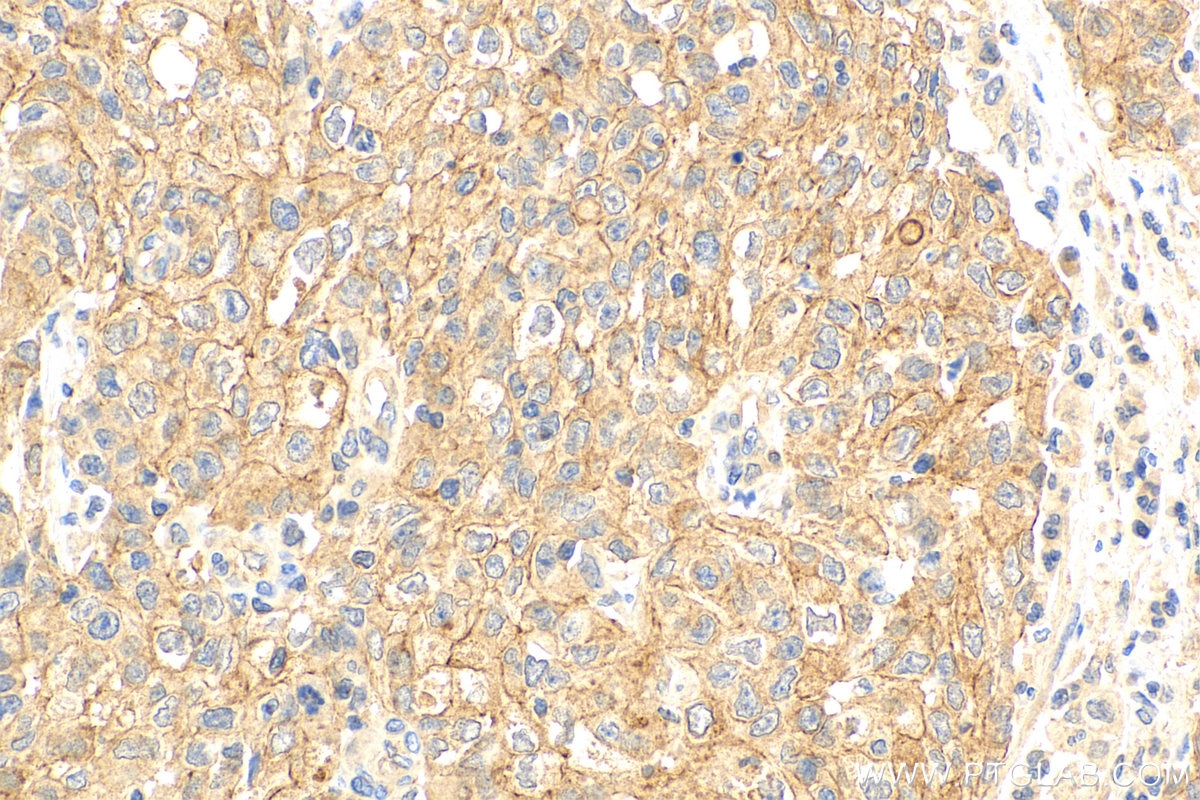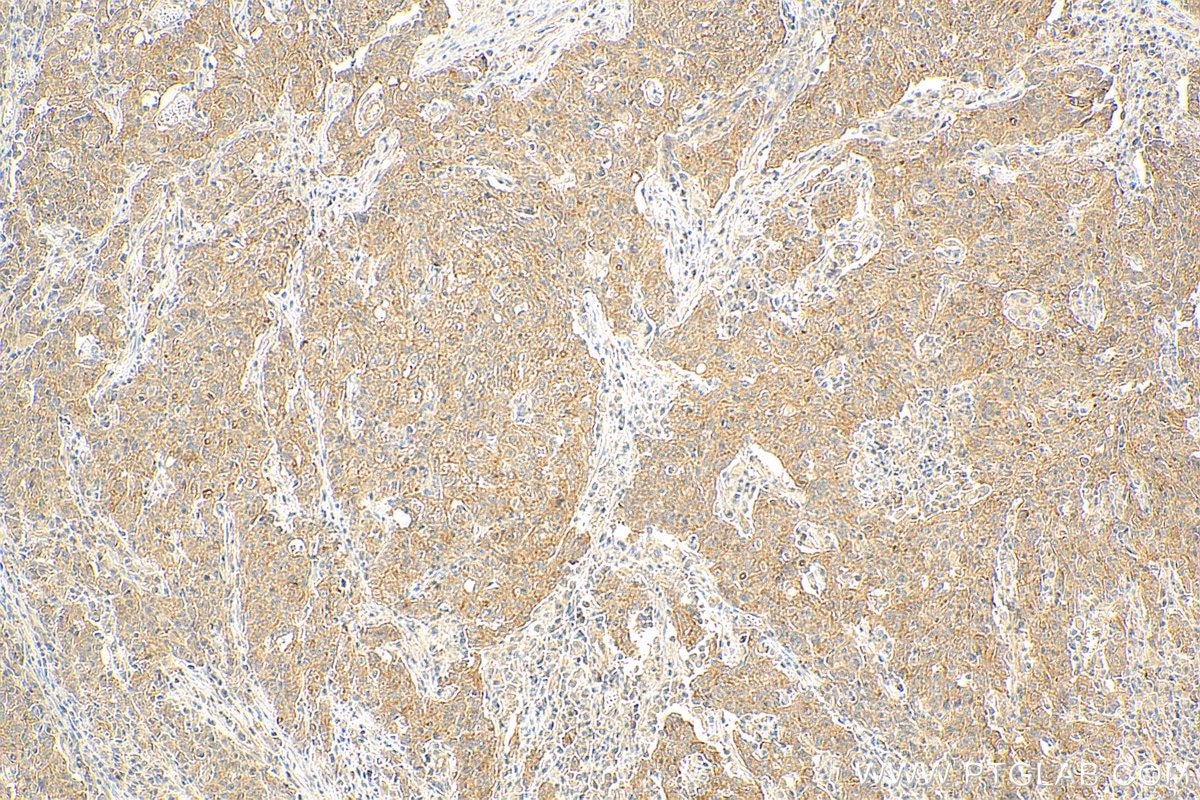C19orf12 Polyklonaler Antikörper
C19orf12 Polyklonal Antikörper für WB, IHC, ELISA
Wirt / Isotyp
Kaninchen / IgG
Getestete Reaktivität
human
Anwendung
WB, IHC, IF, CoIP, ELISA
Konjugation
Unkonjugiert
Kat-Nr. : 27382-1-AP
Synonyme
Geprüfte Anwendungen
| Erfolgreiche Detektion in WB | U2OS-Zellen |
| Erfolgreiche Detektion in IHC | humanes Magenkrebsgewebe Hinweis: Antigendemaskierung mit TE-Puffer pH 9,0 empfohlen. (*) Wahlweise kann die Antigendemaskierung auch mit Citratpuffer pH 6,0 erfolgen. |
Empfohlene Verdünnung
| Anwendung | Verdünnung |
|---|---|
| Western Blot (WB) | WB : 1:150-1:600 |
| Immunhistochemie (IHC) | IHC : 1:50-1:500 |
| It is recommended that this reagent should be titrated in each testing system to obtain optimal results. | |
| Sample-dependent, check data in validation data gallery | |
Veröffentlichte Anwendungen
| KD/KO | See 2 publications below |
| WB | See 4 publications below |
| IHC | See 1 publications below |
| IF | See 1 publications below |
| CoIP | See 1 publications below |
Produktinformation
27382-1-AP bindet in WB, IHC, IF, CoIP, ELISA C19orf12 und zeigt Reaktivität mit human
| Getestete Reaktivität | human |
| In Publikationen genannte Reaktivität | human |
| Wirt / Isotyp | Kaninchen / IgG |
| Klonalität | Polyklonal |
| Typ | Antikörper |
| Immunogen | C19orf12 fusion protein Ag26555 |
| Vollständiger Name | chromosome 19 open reading frame 12 |
| Berechnetes Molekulargewicht | 107 aa, 11 kDa |
| Beobachtetes Molekulargewicht | 20 kDa |
| GenBank-Zugangsnummer | BC063518 |
| Gene symbol | C19orf12 |
| Gene ID (NCBI) | 83636 |
| Konjugation | Unkonjugiert |
| Form | Liquid |
| Reinigungsmethode | Antigen-Affinitätsreinigung |
| Lagerungspuffer | PBS with 0.02% sodium azide and 50% glycerol |
| Lagerungsbedingungen | Bei -20°C lagern. Nach dem Versand ein Jahr lang stabil Aliquotieren ist bei -20oC Lagerung nicht notwendig. 20ul Größen enthalten 0,1% BSA. |
Protokolle
| PRODUKTSPEZIFISCHE PROTOKOLLE | |
|---|---|
| WB protocol for C19orf12 antibody 27382-1-AP | Protokoll herunterladen |
| IHC protocol for C19orf12 antibody 27382-1-AP | Protokoll herunterladenl |
| STANDARD-PROTOKOLLE | |
|---|---|
| Klicken Sie hier, um unsere Standardprotokolle anzuzeigen |
Publikationen
| Species | Application | Title |
|---|---|---|
Free Radic Biol Med C19orf12 ablation causes ferroptosis in mitochondrial membrane protein-associated with neurodegeneration. | ||
Stem Cell Res Generation of four human induced pluripotent stem cell lines derived from patients with MPAN, subtype of NBIA, carrying the c.204_214del11 mutation in the C19orf12 gene | ||
Cell Rep C19orf12 inhibits mitochondrial function and enhances the antitumor effects of metformin in non-small cell lung cancer
|




